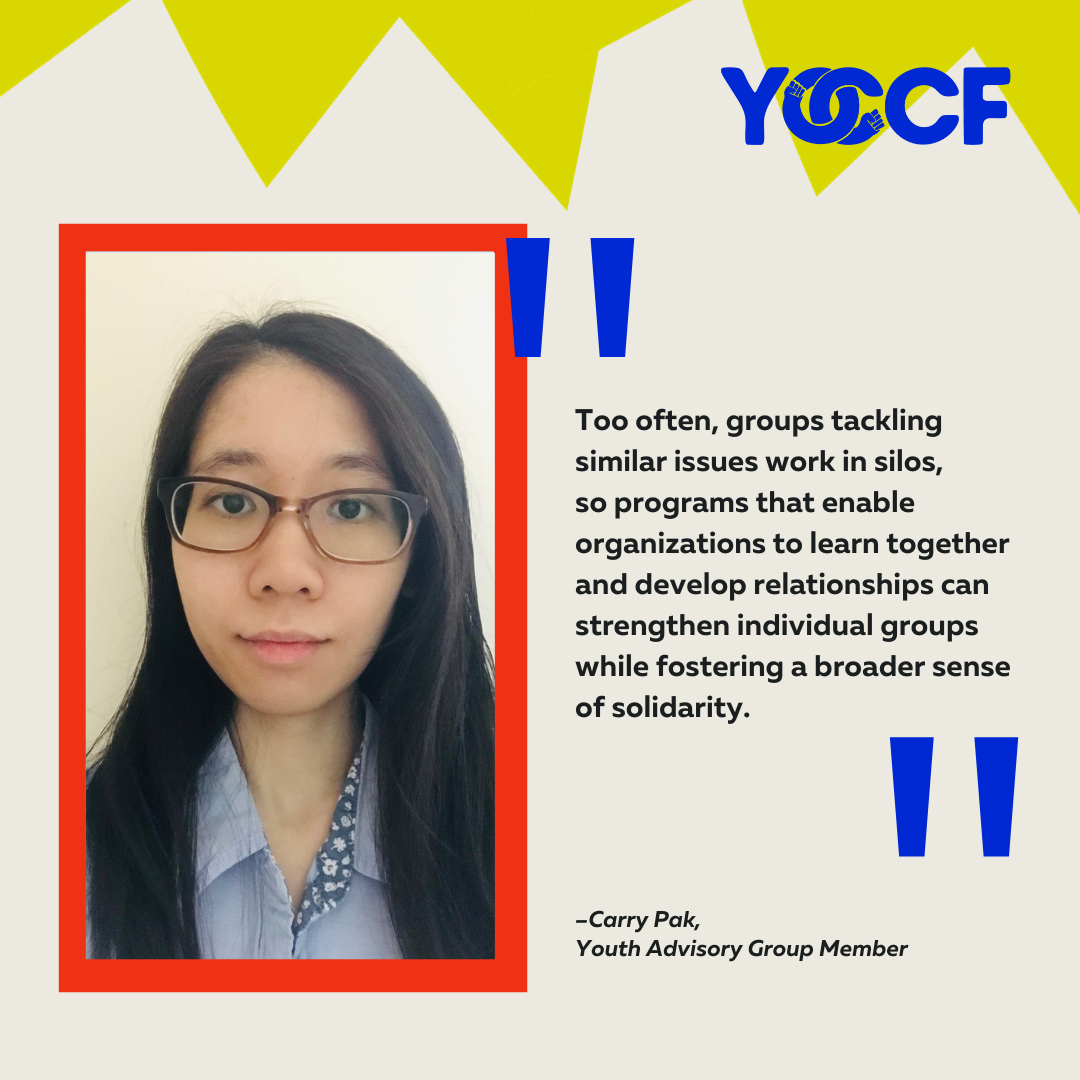 YOCCF is informed and inspired by the young visionaries in the movement. Over the next few weeks, we will highlight some of the extraordinary members of our Youth Advisory Group, who are co-leading a participatory evaluation process to help guide the progress of the Fund and support the inaugural cohort as they grow and thrive.
YOCCF is informed and inspired by the young visionaries in the movement. Over the next few weeks, we will highlight some of the extraordinary members of our Youth Advisory Group, who are co-leading a participatory evaluation process to help guide the progress of the Fund and support the inaugural cohort as they grow and thrive.
In our latest Youth Advisory Group member spotlight, we’re excited to feature Carry Pak, a recent City College of New York graduate with a bachelor’s in architecture and a master’s in sustainability. Outside her studies, Carry is an active member of CAAAV: Organizing Asian Communities, which organizes and builds grassroots community power in Astoria and Chinatown.
We were eager to hear more from Carry’s perspective, and our conversation ranged from her vision for integrating architecture and activism to the insights she’s gained into effective social change strategies through the YOCCF cohort. Read on for her thoughts on community power, the role of art and culture, and advice to fellow young changemakers.
How did you first get involved with CAAAV?
I’ve always been interested in architecture and integrating it with underserved communities. In college, a professor introduced me to community organizing, and I then connected with CAAAV through an internship curriculum. I’ve since been with the organization as a volunteer community leader for a few years.
What do you think has contributed to CAAAV’s focus on housing rights?
There are some members of CAAAV who have been priced out of homes and their community — some more than once. Others have seen their friends or their families struggle with the ever-increasing cost of living in contrast to stagnant income.
I think empathy and relatability are key to the work and building a base. People who’ve experienced or seen housing issues themselves are more drawn to understanding the underlying issues and discussing solutions. CAAAV empowers its members and leaders to work towards a future that makes living a decent life more viable under the current system. Collective power is crucial to the fight for tenants’ rights, affordable housing policies and incentives, and the like.
How do you see art and architecture coming together with housing justice activism?
When thinking about housing in architecture, luxury housing is what commonly comes to mind. However, CAAAV has helped inspire me to try and understand the intersection between architecture and housing justice. My goal is to integrate these two aspects into my work.
I’ve been particularly interested in community engagement in housing projects. In community-based projects, architects and designers sometimes come in with basic concepts proposed and then engage community members in sketching out the details based on what the community needs or wants. This type of design process becomes a dialogue that has opportunities to reflect aspects of its community.
So, I’ve been thinking about that in terms of how we conceptualize and design housing projects, especially when it comes to art and creativity. We’ve talked about something like this in my architectural office before – maybe this community wants murals, art wall, sculptural open space, space for community-based vendors/artists, or to use interesting lighting to increase the sense of safety on the first floor. I think if we engaged communities more to respond to their concerns through architecture, it would integrate art into the process as a medium of engagement.
What have you learned so far from the YOCCF Youth Advisory Group meetings?
It’s been such a great learning experience. I’ve gained insight into things like program evaluation, developing metrics, and different methods for assessing progress toward goals. As a group, we’ve worked on identifying indicators that can help assess if YOCCF is achieving intended milestones and outcomes.
We’ve analyzed different approaches to data collection, like interviews, confessional videos, and surveys based on in-person or remote observations. After each activity, our group, along with the professional evaluators, really talked through what we observed, how we assessed progress, and what alternatives we could suggest in response to obstacles we observed. That collaborative process of sharing perspectives has been really meaningful, and assessment is a multifaceted skill I’m already applying to my daily life. I’ve even started organizing accountability sessions with my friends to make sure we’re reaching our personal goals!
What more could funders be doing to support movement organizations like CAAAV?
While the funding itself is crucial, I think opportunities like YOCCF programming that strategically connects aligned organizations are so valuable for movement building. Too often, groups tackling similar issues work in silos, so programs that enable organizations to learn together and develop relationships can strengthen individual groups while fostering a broader sense of solidarity.
Beyond just funding, supporters enabling this intentional connectivity provide space for skill-sharing, mutual inspiration, and alliance-building across groups. Personally, I’ve seen how powerful it is for our housing justice campaigns when we show up to actions with allied organizations demonstrating a united front. Movements need that momentum of collective power to make a difference, so continuing to fund convenings that unite aligned groups can significantly expand the capacity for collaboration and growth.
Last, and crucially, funders can uplift organizations that are embedded in and led by the directly impacted communities they serve. Those groups hold invaluable knowledge and experience to drive transformative solutions. Financial resources give them sustainability, while forums for exchange give them momentum. That’s where I hope to see more investment — at the intersection of funding and community-driven connection.